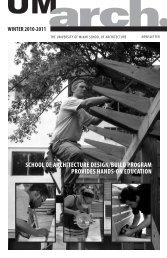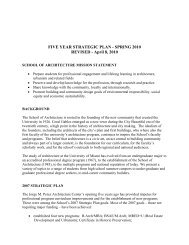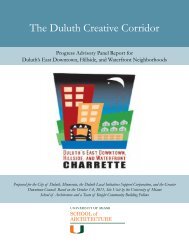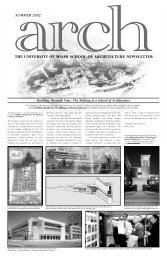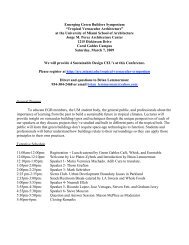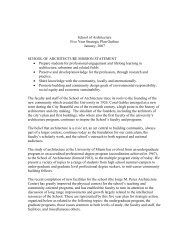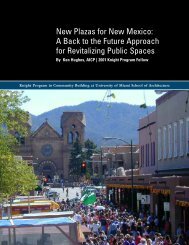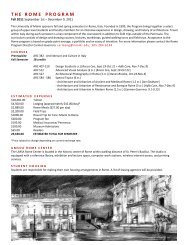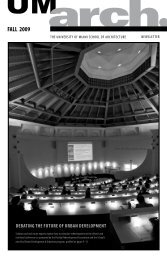Full Report - Knight Program in Community Building
Full Report - Knight Program in Community Building
Full Report - Knight Program in Community Building
Create successful ePaper yourself
Turn your PDF publications into a flip-book with our unique Google optimized e-Paper software.
The Public Process andNew UrbanismBy Jennifer Hurley | 2001 <strong>Knight</strong> <strong>Program</strong> Fellow<strong>Knight</strong> <strong>Program</strong> <strong>in</strong> <strong>Community</strong> Build<strong>in</strong>g at University of Miami School of Architecture
1Contents2Abstract4<strong>Full</strong> <strong>Report</strong>15ResourcesCover PhotoImages of the public process from <strong>Knight</strong> <strong>Program</strong> charrettes.
2The Public Process and New UrbanismBy Jennifer Hurley | 2001 <strong>Knight</strong> <strong>Program</strong> FellowBioJennifer Hurley is a partnerwith Hurley Franks andAssociates, a plann<strong>in</strong>g andurban design firm <strong>in</strong>Philadelphia, Pennsylvania.AbstractThe phrase “public process” refers to a variety of situations related to public<strong>in</strong>volvement <strong>in</strong> plann<strong>in</strong>g and development decisions: public hear<strong>in</strong>gs with plann<strong>in</strong>gcommissions, zon<strong>in</strong>g boards, and city councils; citizen task forces; and urbandesign charrettes. The public process as applied by New Urbanists offers greatbenefits and also presents some difficult problems. This report discusses whatNew Urbanists can learn from specialists <strong>in</strong> public participation and alternativedispute resolution, and what New Urbanists have to teach those same specialists.What Can Charrette Practitioners Learn from Consensus-Build<strong>in</strong>g?By learn<strong>in</strong>g from the experience of mediators and facilitators, charrette organizerscan leverage the event to create more support for the results, ultimatelylead<strong>in</strong>g to more faithful implementation.• A robust theoretical basis for practice can <strong>in</strong>form the understand<strong>in</strong>g of theprocess and suggest possibilities when problems arise.A close relationship between theory-build<strong>in</strong>g and practice development canenrich both. S<strong>in</strong>ce academics have shown little <strong>in</strong>terest <strong>in</strong> charrette practice,practitioners should educate themselves about relevant theories, articulatehow theory can improve practice, and illum<strong>in</strong>ate the holes <strong>in</strong> theory thatpractice uncovers.• Situat<strong>in</strong>g the charrette event <strong>in</strong> a larger decision-mak<strong>in</strong>g framework that<strong>in</strong>cludes pre-charrette outreach and post-charrette consensus-build<strong>in</strong>g<strong>in</strong>creases the chances of implementation.Make sure a community is ready for a collaborative process like a charrette.Include considerations of politics and community organiz<strong>in</strong>g <strong>in</strong> the def<strong>in</strong>itionof “ready.” Make sure key stakeholders will participate. Be clear about therules of engagement, the decision-mak<strong>in</strong>g process and the role of the public.Especially <strong>in</strong> situations with high levels of conflict, make sure the keystakeholders agree with the scope and focus of the charrette.• Us<strong>in</strong>g the charrette to aid group learn<strong>in</strong>g and build<strong>in</strong>g civic capital will leveragethe event to develop local leaders who can champion the plan long afterthe event.Document the stakeholder <strong>in</strong>put. Make notes from stakeholder meet<strong>in</strong>gs,and make those notes available <strong>in</strong> the charrette report or on a project website. Demonstrate how public comment <strong>in</strong>fluenced the products.
3Pay explicit attention to “packag<strong>in</strong>g an agreement” that builds support forlong-term implementation. Incorporat<strong>in</strong>g ongo<strong>in</strong>g evaluation of the processdur<strong>in</strong>g charrettes would <strong>in</strong>crease satisfaction with the experience and theoutcome <strong>in</strong> the short-term. Evaluation of the outcome of charrettes wouldlead to long-term improvements <strong>in</strong> the standard of practice.• Charrette organizers should adopt specific skills from mediators and facilitators,<strong>in</strong>clud<strong>in</strong>g stakeholder analysis, the use of groundrules, neutral mediation/facilitation,agenda-sett<strong>in</strong>g, and consensus-build<strong>in</strong>g techniques.Know the play<strong>in</strong>g field. Conduct a thorough stakeholder analysis at the beg<strong>in</strong>n<strong>in</strong>gof a project and develop the community outreach plan based on thatanalysis. Revisit the stakeholder analysis throughout the process, especiallyas the scope of the project changes. Have a charrette team member whoseprimary responsibility is to focus on the process.What Can Charrette Practitioners Add to Consensus-Build<strong>in</strong>g?Charrettes are a technique that discussion-based mediators and facilitatorsshould learn about.• Charrettes are a great improvement over discussion-based processes foraddress<strong>in</strong>g physical and design issues. Words are a cumbersome mediumwhen the problem is visual.• The compressed time frame of a charrette creates <strong>in</strong>credible excitement andmomentum. In contrast, discussion-based processes can take months, ifnot years, and are often tedious and sometimes downright pa<strong>in</strong>ful.• The large event and spectacle quality of a charrette generates significantmedia <strong>in</strong>terest.• The variety of ways, opportunities and times for people to participate <strong>in</strong> acharrette opens the door to much broader participation than typical discussion-basedprocesses.
4The Public Process and New UrbanismBy Jennifer Hurley | 2001 <strong>Knight</strong> <strong>Program</strong> FellowThe term “public process” is a catch phrase that refers to a variety of contexts<strong>in</strong> which the public participates <strong>in</strong> plann<strong>in</strong>g and development decisions: publichear<strong>in</strong>gs with plann<strong>in</strong>g commissions, zon<strong>in</strong>g boards, and city councils; citizen taskforces; and urban design charrettes. In try<strong>in</strong>g to implement New Urban plann<strong>in</strong>gand development projects, New Urbanists frequently encounter problems generatedby the public process and these problems can be a source of a great deal of frustration.Of course, the public process is not the only situation that has presented obstaclesto New Urbanists, who have developed a methodology for deal<strong>in</strong>g with obstacles:co-opt specialized fields, look to history, and develop new solutions. I suggest thatthe problems of the “public process” simply pose additional arenas <strong>in</strong> which NewUrban generalists must become knowledgeable: community organiz<strong>in</strong>g, politicaladvocacy, adult education, and dispute resolution.When New Urbanists had trouble gett<strong>in</strong>g good places built because of rules bytraffic eng<strong>in</strong>eers, they learned basic traffic eng<strong>in</strong>eer<strong>in</strong>g, found sympathetic trafficeng<strong>in</strong>eers to become New Urban road design experts, and re-wrote the standards.When New Urbanists were disappo<strong>in</strong>ted <strong>in</strong> the quality of built places, they looked tohistory and renewed the practice of us<strong>in</strong>g pattern books to guide builders. Whenmunicipal officials refused to approve New Urban developments because they didnot meet zon<strong>in</strong>g codes, New Urbanists developed entirely new k<strong>in</strong>ds of codes.It is time once aga<strong>in</strong> to turn to these methods. New Urbanists must learn thebasics of community organiz<strong>in</strong>g, adult education, and dispute resolution. We mustanalyze historical examples of political change for clues about how to be effective.We must f<strong>in</strong>d allies amongst the specialists <strong>in</strong> community organiz<strong>in</strong>g and publicparticipation, and teach them about urban design and charrette methods. And oncewe have used these time-tested methods, we will be able to develop creative newapproaches to this problem.Consensus-Build<strong>in</strong>g and New UrbanismTo help us down this path, this report shares some of what I know about publicparticipation and alternative dispute resolution, discuss<strong>in</strong>g what New Urbanists canlearn from specialists <strong>in</strong> this field, and what New Urbanists have to teach thosesame specialists.
HURLEY | THE PUBLIC PROCESS5Over the last thirty years, alternative dispute resolution has grown <strong>in</strong>to a professionalfield of practice, complete with academic theory, field-tested techniques, andpractice area specializations. Public participation and public policy dispute resolutionis one area of specialization. Current practice and theory <strong>in</strong> this area have developedfrom a variety of sources.The Civil Rights and Fem<strong>in</strong>ist movements of the 1950s – 1960s drew attentionto the dynamics of power and promoted <strong>in</strong>dividual self-determ<strong>in</strong>ation and socialequity. The failures of 1960s urban and transportation programs spawned disillusionmentwith government and the role of experts, lead<strong>in</strong>g to demands for, andeventually federal requirements for, more participation of citizens <strong>in</strong> plann<strong>in</strong>g anddevelopment decisions.The 1960s – 1970s environmental regulations issued to implement the NationalEnvironmental Policy Act (NEPA), the Clean Water Act, the Clean Air Act, theEndangered Species Act, and the Comprehensive Environmental Response,Compensation, and Liability Act (CERCLA; a.k.a. Superfund), among others, led togridlock <strong>in</strong> the courts. Environmentalists were dissatisfied because environmentalregulations were on hold; the EPA was dissatisfied because it could not implementCongress’ mandates, and <strong>in</strong>dustry was dissatisfied because of last<strong>in</strong>g uncerta<strong>in</strong>ty.Everyone was unhappy with the high costs and long delays engendered by fight<strong>in</strong>gpolicy battles <strong>in</strong> the courts. They looked to the experience of federal programs tomediate labor disputes, and began to develop multi-party mediation techniques.Because the emphasis was on break<strong>in</strong>g adm<strong>in</strong>istrative and judicial gridlock, the goalof these experiments was to develop consensus among all of the parties.At the same time, the grow<strong>in</strong>g presence of community mediation programs ledto the availability of tra<strong>in</strong>ed mediators <strong>in</strong> community sett<strong>in</strong>gs. Some of these programsexpanded beyond <strong>in</strong>dividual disputes to address community disputes, often relatedto local plann<strong>in</strong>g decisions.All of these forces led to a thriv<strong>in</strong>g field of academic study and professionalpractice. Today, the Association for Conflict Resolution (created by a merger of theSociety for Professionals <strong>in</strong> Dispute Resolution, Academy of Family Mediators, andConflict Resolution Education Network) has eighteen divisions of practice, withover seven thousand members. Universities around the world have departments ofConflict Resolution, <strong>in</strong>clud<strong>in</strong>g several with Ph.D. programs.
HURLEY | THE PUBLIC PROCESS6So what does all of this have to do with New Urbanism? New Urbanists arestruggl<strong>in</strong>g to develop answers to problems that others have already addressed, orat least have studied much longer than we have. To illustrate this po<strong>in</strong>t, I willcompare current consensus-build<strong>in</strong>g practices with New Urbanist charrettes, po<strong>in</strong>t<strong>in</strong>gout ways that New Urbanists could <strong>in</strong>corporate the lessons from consensus-build<strong>in</strong>g<strong>in</strong>to their practices.Theory and PracticeTheory and practice are closely related endeavors <strong>in</strong> the field of consensus-build<strong>in</strong>g.Most academics also practice, and many practitioners contribute to research projects.Professional associations and conferences <strong>in</strong>clude a diverse mix of academics andpractitioners. Consensus-build<strong>in</strong>g practice draws on several streams of well-def<strong>in</strong>edtheory, <strong>in</strong>clud<strong>in</strong>g social psychology, group dynamics, conflict resolution/mediation,systems theory, social network theory, organizational learn<strong>in</strong>g, fem<strong>in</strong>ist theory,and cultural theory. The relationship between consensus-build<strong>in</strong>g theory to practiceis robust: practitioners use theory to ga<strong>in</strong> a deeper understand<strong>in</strong>g of their work;theoreticians test their theory through practice.In contrast, modern-day charrettes seem to be primarily practice-based, draw<strong>in</strong>gvery little from theory. Academics <strong>in</strong> architecture and plann<strong>in</strong>g pay almost no attentionto the way the fields are practiced, and there is very little academic analysis ofcharrette processes. Practitioners believe that charrettes can produce better qualityplans through local <strong>in</strong>put, <strong>in</strong>terdiscipl<strong>in</strong>ary teams, short feedback loops, focusedattention, the creative environment, and public filter<strong>in</strong>g of ideas. A related belief isthat charrettes build support for the plan by creat<strong>in</strong>g a high-quality plan and hav<strong>in</strong>gan open process. These beliefs are empirical; we believe them because we see themto be true <strong>in</strong> practice. However, they are primarily descriptive, and not normative.They describe what happens, but not why it happens. The lack of theory underly<strong>in</strong>gour practice means that we stumble <strong>in</strong> the dark. We do not have an understand<strong>in</strong>gof the dynamics of the overall process, an understand<strong>in</strong>g that could give us directionwhen th<strong>in</strong>gs go wrong.Lesson: A close relationship between theory-build<strong>in</strong>g and practice developmentcan enrich both. S<strong>in</strong>ce academics have shown little <strong>in</strong>terest <strong>in</strong> charrette practice,practitioners should educate themselves about relevant theories and beg<strong>in</strong> toarticulate how theory can improve charrettes as well as identify the holes <strong>in</strong> theorythat experience uncovers.
HURLEY | THE PUBLIC PROCESS 7Stages <strong>in</strong> the ProcessWith<strong>in</strong> the field of consensus-build<strong>in</strong>g, there are well-recognized stages <strong>in</strong> theprocess: (1) assessment/conven<strong>in</strong>g, (2) build<strong>in</strong>g the agreement, (3) implementation,and (4) evaluation. These stages are not purely l<strong>in</strong>ear. Activities <strong>in</strong> one stage maylead participants to revisit an “earlier” stage. However, these stages describe tasksthat must be completed, and provide a framework for understand<strong>in</strong>g the overall arcof the process.Each of these stages relates to aspects of us<strong>in</strong>g charrettes <strong>in</strong> a plann<strong>in</strong>g process.I will discuss each stage <strong>in</strong> turn, describ<strong>in</strong>g the tasks undertaken as part of a consensus-build<strong>in</strong>gprocess, and then discuss<strong>in</strong>g how they relate to charrettes.Step 1: Assessment/Conven<strong>in</strong>gThe assessment/conven<strong>in</strong>g stage is crucial <strong>in</strong> consensus-build<strong>in</strong>g. This stagesets the tone for the entire consensus-build<strong>in</strong>g process. Common tasks undertaken<strong>in</strong> this stage <strong>in</strong>clude:• Stakeholder Analysis• Determ<strong>in</strong>e if collaborative process is appropriate• Secure commitment from stakeholders to participate• Arrange first event/meet<strong>in</strong>g• Agree on ground rules, <strong>in</strong>clud<strong>in</strong>g a decision rule• Choose a facilitator• Stakeholder Tra<strong>in</strong><strong>in</strong>g (if appropriate)“Stakeholder Analysis,” a technique developed as an application of systems theory,has three primary components: identify<strong>in</strong>g the stakeholders; identify<strong>in</strong>g the <strong>in</strong>terests,<strong>in</strong>fluences, resources, and power that those stakeholders have and can use; and mapp<strong>in</strong>gthe relationships among different stakeholders. Identify<strong>in</strong>g the stakeholders simplymeans answer<strong>in</strong>g as completely as possible two questions: “Who can affect the project?”and “Who is affected by the project?” The first question is strategic. Anyone whocan affect the outcome of the plann<strong>in</strong>g and development process should be <strong>in</strong>volvedas early as possible. The second question is driven by concerns about equity. Thesecond and third components of stakeholder analysis provide <strong>in</strong>formation abouthow to <strong>in</strong>fluence the “system,” the group of people who have a relationship to aproject. Some people will need to be <strong>in</strong>volved early and often, some only once,some at certa<strong>in</strong> po<strong>in</strong>ts <strong>in</strong> the decision-mak<strong>in</strong>g process. A thorough stakeholderanalysis prevents unpleasant surprises later <strong>in</strong> the project.
HURLEY | THE PUBLIC PROCESS 8Lesson: Know the play<strong>in</strong>g field. Conduct a thorough stakeholder analysis atthe beg<strong>in</strong>n<strong>in</strong>g of a project and develop the community outreach plan based onthat analysis. Revisit the stakeholder analysis as the scope of the project changes.The last thirty years of experimentation <strong>in</strong> public policy dispute resolutionhave produced great successes, dismal failures, and everyth<strong>in</strong>g <strong>in</strong> between. Inreflect<strong>in</strong>g on the differences between success and failure, mediators have developedguidel<strong>in</strong>es for determ<strong>in</strong><strong>in</strong>g whether or not a collaborative process is appropriate.Guidel<strong>in</strong>es <strong>in</strong>clude consideration of many factors, <strong>in</strong>clud<strong>in</strong>g suitability of the issuesfor negotiation, ripeness for decision, time and resources available, political climate,agency will<strong>in</strong>gness, and underly<strong>in</strong>g <strong>in</strong>terests. This task is similar to ask<strong>in</strong>g if a communityis “charrette-ready.” Where the charrette-ready concept focuses on projectdef<strong>in</strong>ition and data support, the guidel<strong>in</strong>es developed by mediators focus more onprocess and power dynamics.Lesson: Make sure a community is ready for a collaborative process such as acharrette. Include considerations of politics and community organiz<strong>in</strong>g <strong>in</strong> the def<strong>in</strong>itionof “ready.” Make sure key stakeholders will participate and decision-makers will listento their <strong>in</strong>put.One of the first tasks of a collaborative group is to discuss and agree on“ground rules.” Mediators and facilitators use ground rules as a tool to help groupsof people work together productively. Ground rules are especially important <strong>in</strong> situationswith high levels of distrust, strong emotions, and conflict<strong>in</strong>g views. By discuss<strong>in</strong>gthe ground rules openly with participants and ask<strong>in</strong>g for agreement to workunder these rules, the facilitator makes the group members responsible for theirbehavior. At the same time, this agreement empowers the facilitator, because thefacilitator only enforces rules that the group has decided it wants. Typical groundrules <strong>in</strong>clude:• Start and end on time• Listen…Don’t <strong>in</strong>terrupt• Speak up…Everyone is important• Focus on issues, not people• Respect confidentiality• Decide by consensus
HURLEY | THE PUBLIC PROCESS 9Another early task is to agree on a facilitator for the group, whether it is aseparate hired facilitator, or simply group members rotat<strong>in</strong>g to play that role. Thefacilitator is part traffic cop, part gadfly. As traffic cop, the facilitator keeps the groupfocused on the agenda and enforces the ground rules, mak<strong>in</strong>g the group a safe placefor people to discuss ideas and problems. As gadfly, the facilitator asks for clarification,uncovers underly<strong>in</strong>g <strong>in</strong>terests, and tests statements and agreements to see if they hold.Hav<strong>in</strong>g a neutral third party whose job is to focus only on the process frees upother group members to advocate their own positions.Lesson: Have a charrette team member whose primary responsibility is to focuson the process. Be clear about the rules of engagement.As discussed earlier, many collaborative projects are consensus-based. However,the key po<strong>in</strong>t here is to be explicit about how decisions are made and who makesthem. People should know from the very beg<strong>in</strong>n<strong>in</strong>g what role they play. Theparticipatory process should always be tied directly to a decision-mak<strong>in</strong>g process.In charrettes, the role of participants is typically advisory. The designers use that<strong>in</strong>put to develop and improve the plan, but the City Council makes the decisionabout whether or not to adopt the plan. Although charrettes are transparent <strong>in</strong>the sense that the meet<strong>in</strong>gs and events dur<strong>in</strong>g the charrette are public and publicized,there is not always a clear explanation of how the charrette fits <strong>in</strong>to the larger policymak<strong>in</strong>gframework.Lesson: Be clear about the decision-mak<strong>in</strong>g process and the role of the public.In some cases, one or more parties <strong>in</strong> a collaborative process may need tra<strong>in</strong><strong>in</strong>gto participate effectively, tra<strong>in</strong><strong>in</strong>g <strong>in</strong> either the process or <strong>in</strong> the substantive issues.This task is especially important if parties have very different levels of education orskills. The Open<strong>in</strong>g Presentation common <strong>in</strong> New Urbanist charrettes plays this role.Some of the activities common <strong>in</strong> the assessment/conven<strong>in</strong>g stage are conductedby the charrette sponsor and the designers as part of the RFP and contract<strong>in</strong>g process.For example, the client usually identifies some of the important stakeholders andtheir <strong>in</strong>terests. That task is cont<strong>in</strong>ued <strong>in</strong> the public meet<strong>in</strong>gs held dur<strong>in</strong>g charrettes.However, I believe that more thorough attention to the tasks of this stage wouldleverage the power of a charrette to spark last<strong>in</strong>g change <strong>in</strong> a community.Strategically, I th<strong>in</strong>k that more attention to these tasks would lead to more frequentand more faithful implementation of charrette plans.
HURLEY | THE PUBLIC PROCESS 10Step 2: Build<strong>in</strong>g the AgreementIn charrette terms, this step <strong>in</strong>volves develop<strong>in</strong>g the plan. Tasks that make upthis phase <strong>in</strong>clude:• Def<strong>in</strong>e the problem/task (<strong>in</strong>cludes discussion of positions/<strong>in</strong>terests)• Generate options/bra<strong>in</strong>storm<strong>in</strong>g• Analyze options• Po<strong>in</strong>t fact-f<strong>in</strong>d<strong>in</strong>g• Package the agreement• Test the agreement• Secure support from constituentsSome mediation models place heavy emphasis on the group def<strong>in</strong><strong>in</strong>g the problemor agree<strong>in</strong>g on the task. Gett<strong>in</strong>g to that agreement <strong>in</strong>volves discuss<strong>in</strong>g each party’spositions, and hopefully identify<strong>in</strong>g the <strong>in</strong>terests that underlie those positions. Ifeveryone can come to a common def<strong>in</strong>ition of what the problems are, and agreethat the underly<strong>in</strong>g <strong>in</strong>terests are legitimate, develop<strong>in</strong>g a solution that is mutuallysatisfy<strong>in</strong>g is much easier than if all of the parties are pull<strong>in</strong>g <strong>in</strong> different directions.In a consensus-build<strong>in</strong>g process, the stakeholders usually work together todevelop a jo<strong>in</strong>t def<strong>in</strong>ition of the problem. In a charrette, the clients and designersusually def<strong>in</strong>e the scope (problems to address, tasks to accomplish) dur<strong>in</strong>g the RFPand contract<strong>in</strong>g process. Although some adjustment to the scope is often madedur<strong>in</strong>g a charrette, there is rarely an explicit discussion with all of the stakeholdersabout what the scope should be. In many cases, leav<strong>in</strong>g out this task as an explicitstep is probably f<strong>in</strong>e. However, if stakeholders have very different ideas about whichissues should be addressed, they may be resistant to any proposals that are <strong>in</strong>troduced.If you experience seem<strong>in</strong>gly irrational resistance to proposals dur<strong>in</strong>g a charrette, itmay be because people are upset about a different problem.Lesson: Especially <strong>in</strong> situations with high levels of conflict, make sure the keystakeholders agree with the scope and focus of the charrette.Charrettes excel at three tasks <strong>in</strong> this stage: bra<strong>in</strong>storm<strong>in</strong>g, analyz<strong>in</strong>g theoptions, and jo<strong>in</strong>t fact-f<strong>in</strong>d<strong>in</strong>g. The synergy of hav<strong>in</strong>g a variety of specialists, theshort feed-back loops, and the public transparency of the analysis are some of thestrengths of the charrette process.Lesson: Facilitators and mediators would benefit from learn<strong>in</strong>g about charrettepractices for creat<strong>in</strong>g and filter<strong>in</strong>g physical design options.
HURLEY | THE PUBLIC PROCESS 11Because facilitators and mediators pay explicit attention to develop<strong>in</strong>g groundrules, <strong>in</strong>clud<strong>in</strong>g a decision rule, consensus-build<strong>in</strong>g processes are usually tied veryclosely to a legally required decision-mak<strong>in</strong>g process. In addition, because consensus-build<strong>in</strong>g<strong>in</strong>cludes a step <strong>in</strong> which the group def<strong>in</strong>es the problem or task, thegroup def<strong>in</strong>es the product. The product of a consensus-build<strong>in</strong>g process is often astatement of agreement by all of the stakeholders. Frequently, this statement providesrecommendations to the body with legal decision-mak<strong>in</strong>g authority. F<strong>in</strong>ally, mediatorsand facilitators are tra<strong>in</strong>ed to “test” an agreement, to make sure that all of the partieshave thought through the implications of the recommendation and that the agreementwill be resilient. These three factors mean that consensus-build<strong>in</strong>g processeswork to package an agreement that all parties will actively support.In a charrette, the product of the process is usually def<strong>in</strong>ed by the sponsor andthe designers through the RFP and contract<strong>in</strong>g process. The sponsor may or maynot be explicit about how the charrette fits <strong>in</strong>to a larger decision-mak<strong>in</strong>g process.Even when the sponsor is explicit with the designers about how the charrette fits<strong>in</strong>to the larger decision-mak<strong>in</strong>g process, that connection is not always emphasizedwith the public. Commonly, the products of the charrette comprise plans or regulationsthat the designers recommend that a legal body, usually the City Council,adopt. There is substantial stakeholder <strong>in</strong>put through meet<strong>in</strong>gs and p<strong>in</strong>-up sessionsheld throughout the charrette, but there is not usually an explicit attempt to reachconsensus among all of the stakeholders. Because of the short time frame, the productis not always completely f<strong>in</strong>ished when the charrette ends. All of these factorstogether contribute to charrettes creat<strong>in</strong>g products (plans and regulations) that donot get implemented.Lesson: Be clear about how the charrette fits <strong>in</strong>to the larger decision-mak<strong>in</strong>gsystem. Be clear with members of the public about what their role is. Pay explicitattention to “packag<strong>in</strong>g an agreement” that satisfies most parties. Question peoplewhen they agree with you. Tie up the loose ends.Step 3: ImplementationThe third major phase of consensus-build<strong>in</strong>g is implementation. People <strong>in</strong>volved<strong>in</strong> consensus-build<strong>in</strong>g <strong>in</strong>clude implementation as a phase of the consensus-build<strong>in</strong>gprocess (and not someth<strong>in</strong>g else altogether) for two primary reasons. First, legislativebodies cannot legally give away their authority to make decisions. That is why theproduct of a consensus-build<strong>in</strong>g process is usually a set of recommendations to alegal body. In early public policy dispute resolution experiments, people sometimesdevoted extensive amounts of time and resources to processes that led nowhere,because the legal authority ignored the collaborative group’s recommendation.
HURLEY | THE PUBLIC PROCESS 12Experiences of that k<strong>in</strong>d led to the realization that anyone who cared about a projecthad to follow it through implementation. At the same time, mediators saw thatpeople who agreed to a course of action sometimes had to re-negotiate their agreements,either because flaws <strong>in</strong> the agreement became apparent dur<strong>in</strong>g implementation,or because the circumstances changed.Tasks common to the implementation phase of consensus-build<strong>in</strong>g <strong>in</strong>clude:• Document the process• Publicize the agreement• Influence legal decision-mak<strong>in</strong>g• Take action• Monitor actions• Re-negotiateDocument<strong>in</strong>g the process is taken very seriously <strong>in</strong> public policy dispute resolutionfor several reasons. To keep the size of a group manageable, participants <strong>in</strong> thecollaborative process are often represent<strong>in</strong>g entire <strong>in</strong>terest groups. Those representativesmust be able to keep their group apprised of the negotiations. Public policydispute resolution takes time, sometimes years, and <strong>in</strong>dividuals who jo<strong>in</strong> the group<strong>in</strong> the middle of the process must understand what came before. Perhaps mostimportantly, document<strong>in</strong>g the process adds to the transparency, and thus legitimacy,of the process with legislators and the general public. This transparency and legitimacymake it more likely that the group’s recommendations will be adopted.Charrettes typically have extraord<strong>in</strong>ary stakeholder <strong>in</strong>put. The uniqueness andspectacle of the event generate extensive media attention and public participation.The breadth of topics covered and the number of citizens participat<strong>in</strong>g is impressive.However, this <strong>in</strong>put is rarely documented <strong>in</strong> a methodical way. People who are <strong>in</strong>the room see that their comments led to changes <strong>in</strong> the draw<strong>in</strong>gs, but everyoneelse—the rest of the public and many of the decision-makers—have no idea howpublic comment affected the plan. People who did not participate can always claimthat their concerns were not addressed, because there is no record of what concernswere addressed.Lesson: Document the stakeholder <strong>in</strong>put. Make notes from stakeholder meet<strong>in</strong>gs,and make those notes available <strong>in</strong> the charrette report or on a project web site.Demonstrate how public comment <strong>in</strong>fluenced the products.
HURLEY | THE PUBLIC PROCESS 13Charrettes typically do a very good job of publiciz<strong>in</strong>g the product of the charrette(<strong>in</strong> consensus-build<strong>in</strong>g terms, the agreement). Because of the spectacle of theevent and the short time frame, media <strong>in</strong>terest is high. New Urbanists have revivedthe art of mak<strong>in</strong>g beautiful plans, and the images developed dur<strong>in</strong>g the charrettemake good graphics for presentations and publications.Lesson: Facilitators and mediators would benefit from learn<strong>in</strong>g about the mediastrategies of New Urbanist charrette practitioners and the power of visual representation.Because of the explicit tie to a legal decision-mak<strong>in</strong>g process often made dur<strong>in</strong>ga consensus-build<strong>in</strong>g process, participants recognize that the process is not completewhen the group makes its recommendations; the process is not complete untilthe legal decision-makers act. Often, participants <strong>in</strong> a consensus-build<strong>in</strong>g processcare so strongly about the outcome that they place political pressure on the legaldecision-makers to adopt the group’s recommendations. They become the proponentsof the recommendations, and fight all of the small battles that appear.Monitor<strong>in</strong>g the actions that participants agreed to take is often an explicit partof the consensus-build<strong>in</strong>g process. Individuals must act, and the consensus-build<strong>in</strong>ggroup monitors those actions to make sure their <strong>in</strong>tent is followed. As problemsarise, the participants re-negotiate their agreements. For a charrette to be fullysuccessful, local people must monitor the implementation actions of governmentagencies and private <strong>in</strong>terests.Lesson: By adopt<strong>in</strong>g some of the practices of mediators and facilitators, charretteorganizers could leverage the charrette process to create and energize local leaderswho will fight for the plan long after the charrette is over.Step 4: EvaluationDraw<strong>in</strong>g on <strong>in</strong>sights from adult education, mediators and facilitators <strong>in</strong>cludeevaluation of the process as part of standard practice. Evaluation of the process <strong>in</strong>an ongo<strong>in</strong>g way has several benefits:• It models a new way of work<strong>in</strong>g together, one that encourages self-reflectionand cont<strong>in</strong>ual improvement• It signals to people that they can disagree or provide criticism• It gives people another chance to be heard• It provides the facilitator, <strong>in</strong> a short feedback loop, with <strong>in</strong>put about theprocess, which can act as an “early warn<strong>in</strong>g system” to make the facilitatoraware of problems
HURLEY | THE PUBLIC PROCESS 14In addition, because dissatisfaction with costs and outcomes of the legal systemled to the development of public policy mediation, there has been significantattention, both from academics and practitioners, to evaluat<strong>in</strong>g the outcomes ofconsensus-build<strong>in</strong>g processes. These evaluations have provided useful <strong>in</strong>sight <strong>in</strong>towhat works and what doesn’t, and have added to improvement of the practice.Lesson: Incorporat<strong>in</strong>g ongo<strong>in</strong>g evaluation of the process dur<strong>in</strong>g charrettes would<strong>in</strong>crease satisfaction with the experience <strong>in</strong> the short-term. Evaluation of the outcomeof charrettes would lead to long-term improvements <strong>in</strong> the standard of practice.What Can Charrette Practitioners Learn from Consensus-Build<strong>in</strong>g?By learn<strong>in</strong>g from the experience of mediators and facilitators, charrette organizerscould leverage the event to create more support for the results of the charrette,result<strong>in</strong>g <strong>in</strong> more faithful implementation. Key aspects that charrette organizerscould learn from consensus-build<strong>in</strong>g:• A robust theoretical basis for practice can <strong>in</strong>form the understand<strong>in</strong>g of theprocess and suggest possibilities when problems arise.• Situat<strong>in</strong>g the charrette event <strong>in</strong> a larger decision-mak<strong>in</strong>g framework that<strong>in</strong>cludes pre-charrette outreach and post-charrette consensus-build<strong>in</strong>g<strong>in</strong>creases the chances of implementation.• Us<strong>in</strong>g the charrette to aid group learn<strong>in</strong>g and build civic capital wouldleverage the event to develop local leaders who can champion the planlong after the event.Charrette organizers could adopt specific skills from mediators and facilitators,<strong>in</strong>clud<strong>in</strong>g stakeholder analysis, the use of ground rules, neutral mediation/facilitation,agenda-sett<strong>in</strong>g, and consensus-build<strong>in</strong>g techniques.What Can Charrette Practitioners Add to Consensus-Build<strong>in</strong>g?I have focused this article on describ<strong>in</strong>g what I th<strong>in</strong>k charrette organizerscan learn from consensus-build<strong>in</strong>g. However, I also believe that charrettes are atechnique that discussion-based mediators and facilitators should learn about:• Charrettes are a great improvement over discussion-based processes foraddress<strong>in</strong>g physical and design issues. Words are a cumbersome mediumwhen the problem is visual.• The compressed time frame of a charrette creates <strong>in</strong>credible excitement andmomentum. In contrast, discussion-based processes can take months, if notyears, and are often tedious and sometimes downright pa<strong>in</strong>ful.
HURLEY | THE PUBLIC PROCESS 15• The large event and spectacle quality of a charrette generates significantmedia <strong>in</strong>terest.• The variety of ways, opportunities, and times for people to participate <strong>in</strong>a charrette opens the door to much broader participation than typicaldiscussion-based processes.ResourcesFor Further Read<strong>in</strong>gDoyles, Michael, and David Straus. How to Make Meet<strong>in</strong>gs Work. New York:Jove Books, 1982.SPIDR Environment/Public Disputes Sector Critical Issues Committee, 1997.“Best Practices for Government Agencies: Guidel<strong>in</strong>es for Us<strong>in</strong>g CollaborativeAgreement-Seek<strong>in</strong>g Processes.” Accessed athttp://www.acresolution.org/research.nsf/key/EPPbestpractices.Sussk<strong>in</strong>d, Lawrence, and Jeffrey Cruikshank. Break<strong>in</strong>g the Impasses: ConsensualApproaches to Resolv<strong>in</strong>g Public Disputes. New York: Basic Books, 1989.Professional OrganizationsAssociation for Conflict Resolution: http://www.acresolution.org.See especially the Environment Public Policy Section:http://www.acresolution.org/research.nsf/key/Sec-EPP.Tra<strong>in</strong><strong>in</strong>gLocal community mediation centers are good places to get tra<strong>in</strong><strong>in</strong>g <strong>in</strong>basic mediation. You can look up mediation centers by location on thewebsite of the National Association for <strong>Community</strong> Mediation athttp://www.nafcm.org/pg35.cfm.More specialized tra<strong>in</strong><strong>in</strong>g is available through the L<strong>in</strong>coln Instituteof Land Policy: http://www.l<strong>in</strong>coln<strong>in</strong>stitute.edu.See especially their Mediat<strong>in</strong>g Land Use Disputes course series.





